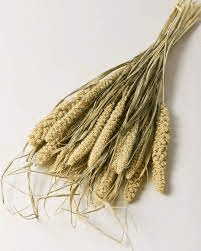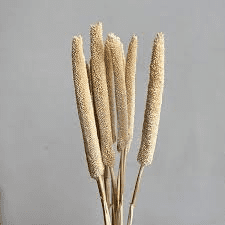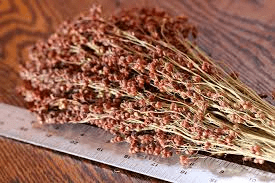Millet stalks are the stems of millet plants, which support the growth of millet seeds. These stalks, like the seeds, play a crucial role in agriculture, especially in regions where millet is a staple crop. Millet is a group of small-seeded grasses, and the stalks vary in size and strength depending on the specific type of millet being cultivated. Some of the most common types of millet include pearl millet, foxtail millet, proso millet, and finger millet.
Millet stalks are typically sturdy and resilient, which helps the plant withstand harsh environmental conditions. This resilience is particularly important in areas with poor soil quality and limited rainfall. The ability of millet stalks to thrive in such conditions makes millet a vital crop in many developing countries, providing a reliable food source where other crops might fail.
The stalks of millet plants have several uses beyond their role in supporting the seeds. One of the primary uses is as fodder for livestock. After harvesting the seeds, the remaining stalks can be dried and stored as feed. This is especially valuable in regions where other sources of animal feed are scarce. Millet stalks are nutritious for animals, providing essential fibers and nutrients that contribute to their overall health.
In addition to being used as animal fodder, millet stalks are also utilized in various traditional practices. In many rural communities, the stalks are used as thatching material for roofs, providing an affordable and effective means of shelter. The stalks are woven together to create a dense, water-resistant covering that can last for several years. This use of millet stalks is particularly common in parts of Africa and Asia, where traditional construction methods remain prevalent.
Millet stalks also contribute to soil health and agricultural sustainability. When left in the field after harvest, the decomposing stalks add organic matter to the soil, improving its fertility and structure. This process, known as green manuring, helps retain soil moisture and promotes the growth of beneficial microorganisms. By enhancing soil quality, millet stalks contribute to better yields for future crops, making them an integral part of sustainable farming practices.
In some regions, millet stalks are used as a source of fuel. The dried stalks can be burned to produce heat for cooking and heating. This use of millet stalks is particularly important in rural areas where access to other forms of energy, such as electricity or gas, is limited. By providing a readily available source of fuel, millet stalks help meet the basic energy needs of many households.
The industrial uses of millet stalks are also being explored. Researchers are investigating ways to convert millet stalks into biofuels, which could provide a renewable energy source and reduce dependence on fossil fuels. Additionally, the fibers from millet stalks can be used to produce biodegradable materials, contributing to efforts to reduce plastic waste.
In conclusion, millet stalks are a versatile and valuable part of the millet plant. Their uses range from animal fodder and thatching material to soil enrichment and fuel. The resilience and utility of millet stalks make them an important resource in many parts of the world, particularly in regions where millet is a staple crop. As research continues to uncover new applications for millet stalks, their importance in agriculture and industry is likely to grow, contributing to sustainable practices and improved livelihoods.
The Economic Importance and Uses of Millet Stalks

1. Animal Feed: Millet stalks are used as feed for livestock. They provide essential roughage and nutrients for cattle, sheep, and goats. Farmers often chop the stalks and mix them with other feeds.
2. Fodder: Fresh millet stalks are used as green fodder for animals. They are harvested and fed to livestock immediately, providing a nutritious and palatable option.
3. Building Material: In rural areas, millet stalks are used as a building material. They are often used to make thatched roofs and walls for huts and other structures.
4. Biofuel: Millet stalks can be converted into biofuel. They are processed to produce ethanol, which is used as a renewable energy source.
5. Mulching: Farmers use millet stalks as mulch to protect the soil. Mulching helps retain soil moisture, reduce weed growth, and improve soil health.
6. Compost: Millet stalks are used in composting. They decompose to form organic compost, which enriches the soil and promotes healthy plant growth.
7. Erosion Control: Millet stalks are used to control soil erosion. They are placed on slopes and other vulnerable areas to prevent soil from being washed away by rain.
8. Bedding Material: Millet stalks are used as bedding material for livestock. They are soft and absorbent, providing a comfortable and clean resting place for animals.
9. Paper Production: Millet stalks can be processed to make paper. The fibers are extracted, pulped, and then formed into sheets of paper.
10. Handicrafts: Millet stalks are used in making handicrafts such as baskets, mats, and decorative items. Artisans weave and shape the stalks into various products.
11. Biochar: Millet stalks can be converted into biochar through pyrolysis. Biochar is a form of charcoal that improves soil fertility and sequesters carbon.
12. Mushroom Cultivation: Millet stalks serve as a substrate for mushroom cultivation. They provide the necessary nutrients for mushroom growth.
13. Biomass Energy: Millet stalks are used as a source of biomass energy. They are burned or gasified to produce heat and electricity.
14. Paper Pulp: Millet stalks are used to make paper pulp. The stalks are processed to extract cellulose fibers, which are then used in paper manufacturing.
15. Craft Materials: Millet stalks are used in various crafts and DIY projects. They can be woven, painted, and shaped into different artistic creations.
16. Soil Amendment: Millet stalks, when decomposed, act as a soil amendment. They add organic matter to the soil, improving its structure and fertility.
17. Animal Housing: Millet stalks are used in constructing animal shelters and enclosures. They provide insulation and protection from the elements.
18. Fuel Briquettes: Millet stalks can be compressed into fuel briquettes. These briquettes are used as an alternative to wood and charcoal for cooking and heating.
Read Also: 25 Medicinal Health Benefits Of Astragalus amphioxys (Crescent milkvetch)
The Products and By-products That Can Be Derived From Millet Stalks

1. Biofuel: Millet stalks can be converted into biofuel through processes like fermentation and distillation. The biofuel can be used to power vehicles and machinery.
2. Biomass Pellets: Millet stalks are compressed into biomass pellets, which are used as a renewable energy source for heating and electricity generation.
3. Animal Feed: Dried and chopped millet stalks are used as roughage in animal feed. They are mixed with other feed components to provide a balanced diet for livestock.
4. Paper: Millet stalks are processed into paper. The stalks are pulped, refined, and formed into paper sheets, which are then dried and finished.
5. Handicrafts: Millet stalks are used to make various handicrafts such as baskets, mats, and ornaments. Artisans weave and shape the stalks into different items.
6. Mulch: Millet stalks are used as mulch to cover the soil. Mulch helps retain moisture, suppress weeds, and regulate soil temperature.
7. Compost: Millet stalks are added to compost piles. They decompose to form nutrient-rich compost, which is used to fertilize crops and gardens.
8. Biochar: Millet stalks are pyrolyzed to produce biochar. Biochar is used to improve soil fertility, increase water retention, and reduce greenhouse gas emissions.
9. Bedding: Millet stalks are used as bedding material for livestock. They are absorbent and provide a comfortable resting place for animals.
10. Erosion Control: Millet stalks are used to create barriers for erosion control. They help stabilize the soil and prevent it from being washed away by water.
11. Mushroom Substrate: Millet stalks are used as a substrate for growing mushrooms. The stalks provide nutrients and support for mushroom cultivation.
12. Fuel Briquettes: Millet stalks are compressed into briquettes, which are used as a fuel source for cooking and heating. The briquettes burn efficiently and produce less smoke.
13. Insulation Material: Millet stalks are used as an insulation material in construction. They provide thermal insulation and help reduce energy consumption.
14. Building Material: Millet stalks are used to construct walls and roofs for huts and other structures. They are durable and provide good insulation.
15. Craft Materials: Millet stalks are used in various craft projects. They can be woven, painted, and shaped into different artistic creations.
16. Animal Shelters: Millet stalks are used to build shelters for livestock. The shelters provide protection from the weather and keep the animals safe.
17. Green Fodder: Fresh millet stalks are fed to livestock as green fodder. They are nutritious and help improve the health and productivity of the animals.
Read Also: 25 Medicinal Health Benefits Of Gentianella alborosea (Hercampuri)
Frequently Asked Questions (FAQ’s) About Millet Stalks

1. What are millet stalks?
Millet stalks are the stems and leaves of millet plants left after the seeds are harvested.
2. How are millet stalks used in agriculture?
Millet stalks are used as animal feed, mulch, compost, and for erosion control in agricultural practices.
3. Can millet stalks be used as biofuel?
Yes, millet stalks can be converted into biofuel through fermentation and distillation processes.
4. What are the environmental benefits of using millet stalks?
Using millet stalks helps reduce waste, improve soil health, and provide a renewable energy source, contributing to environmental sustainability.
5. How are millet stalks used in construction?
Millet stalks are used to make thatched roofs and walls for huts and other structures, providing insulation and protection.
6. Can millet stalks be used in mushroom cultivation?
Yes, millet stalks serve as a substrate for growing mushrooms, providing necessary nutrients for their growth.
7. What are the nutritional benefits of using millet stalks as animal feed?
Millet stalks provide roughage and essential nutrients for livestock, supporting their growth and health.
8. How do millet stalks help in soil erosion control?
Millet stalks are placed on slopes and vulnerable areas to prevent soil from being washed away by rain, stabilizing the soil.
9. Can millet stalks be used to make paper?
Yes, millet stalks can be processed into paper by extracting and pulping their cellulose fibers.
10. Are there any craft uses for millet stalks?
Yes, millet stalks are used to create various handicrafts such as baskets, mats, and decorative items.
Read Also: Business Planning Process and Importance of Business Plan






